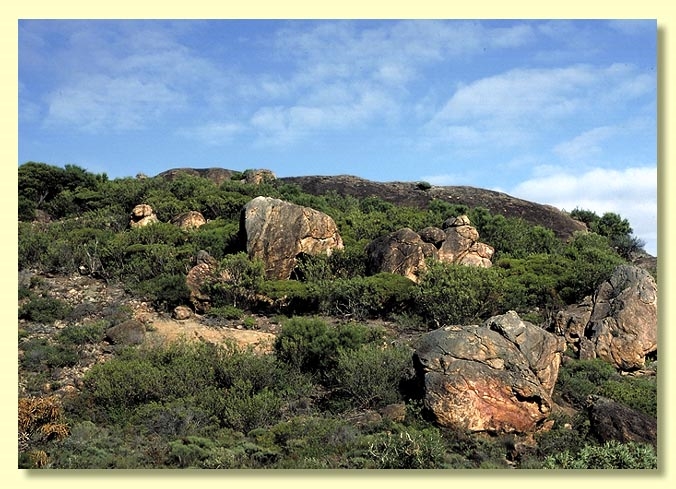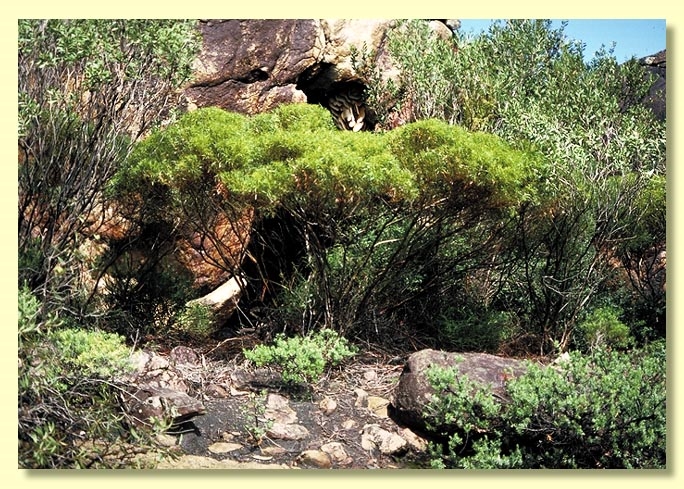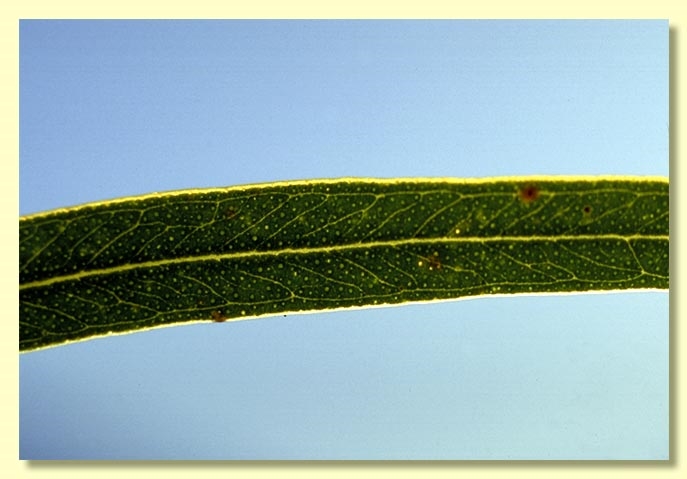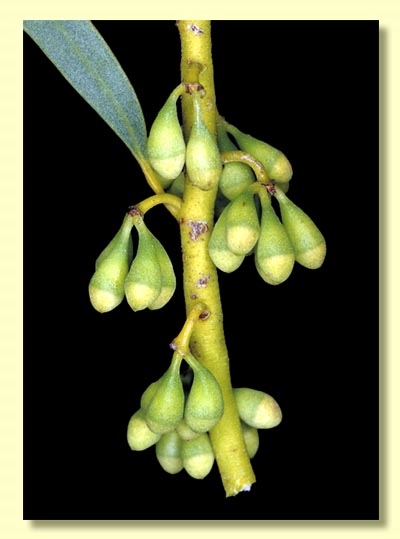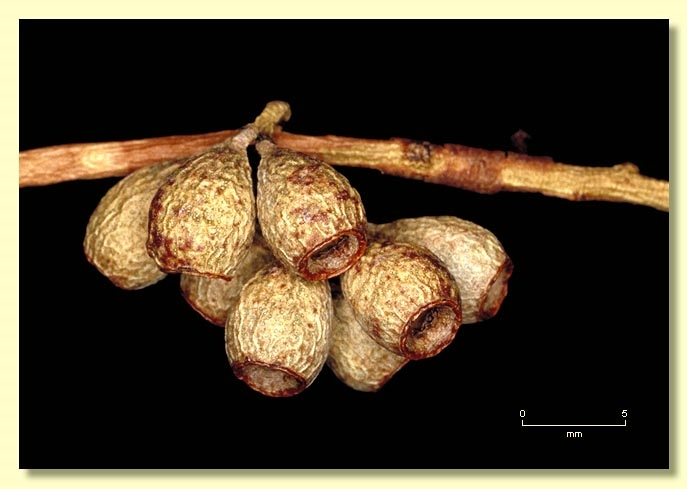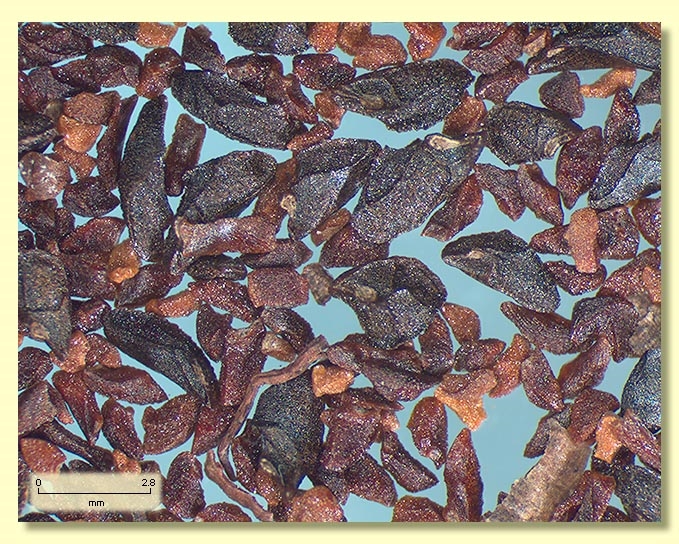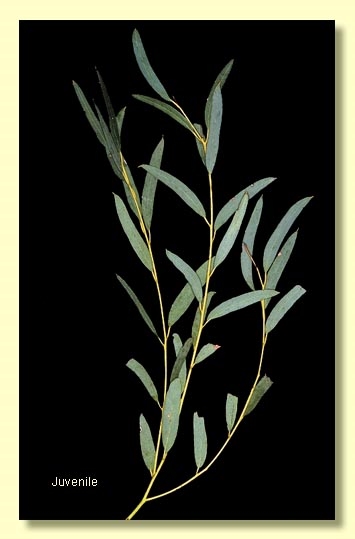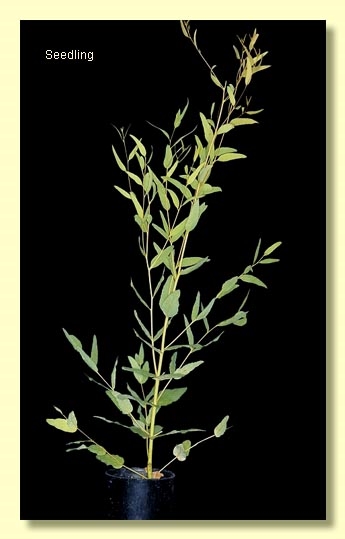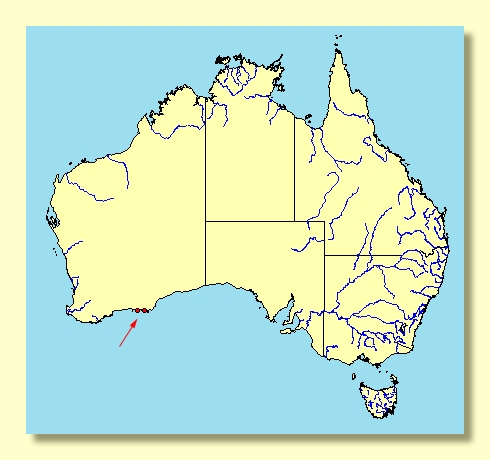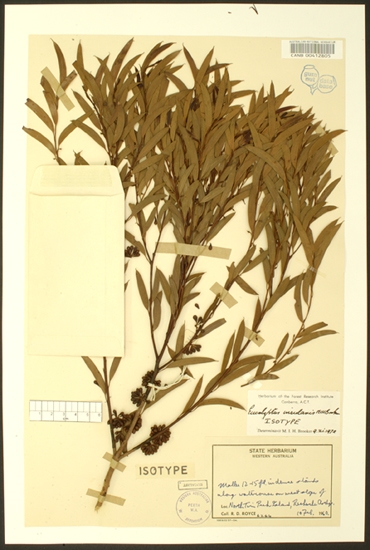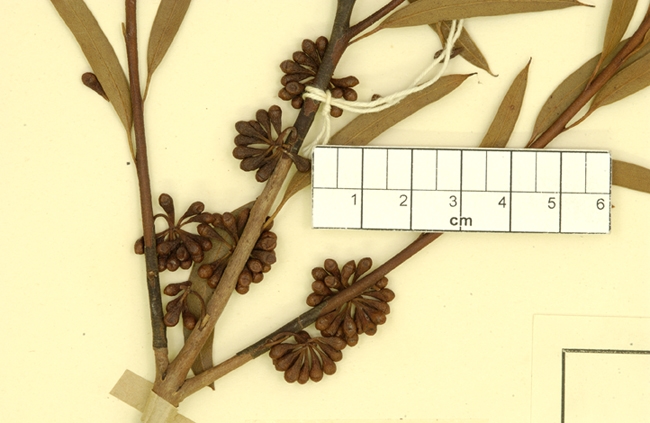Euclid - Online edition
Eucalyptus insularis
Eucalyptus | Eucalyptus | Longistylus | Unicae
T: North Twin Peak Is., W.A., 33°59S, 122°51E, 10 Feb. 1960, R.D.Royce 6264; holo: PERTH; iso: CANB.
Mallee to 3 m tall (rarely to 8 m). Forming a lignotuber.
Bark smooth throughout on smaller plants, greenish grey to pale grey and pale bronze, some basal fibrous grey-brown bark on largest stems.
Branchlets lacking oil glands in the pith.
Juvenile growth (coppice or field seedlings to 50 cm): stems rounded in cross-section, warty at least on lower stems; juvenile leaves opposite and sessile at lowest nodes then becoming petiolate, alternate, oblong to lanceolate 3.5–5.5 cm long, 0.8–1.5 cm wide, margin distantly toothed (warts), blue-green or green.
Adult leaves alternate, petioles 0.4–0.8 cm long; blade linear, thin-textured, 1.8–6.8 cm long, (0.3)0.4–0.9 cm wide, base tapering to petiole, margin entire, apex pointed, concolorous, dull, green, side-veins acute, reticulation sparse or obscure, intramarginal vein present, oil glands island.
Inflorescence axillary unbranched, gracefully pendulous, peduncles 0.3–0.8 cm long, buds 9 to more than 20 per umbel, pedicels 0.2–0.4 cm long. Mature buds obovoid to ovoid, 0.4–0.6 cm long, 0.2–0.3 cm wide, whitish-green (non-glaucous or rarely slightly glaucous), scar absent, the single operculum rounded to bluntly conical, stamens inflexed, anthers cuboid, versatile, dorsifixed, dehiscing by longitudinal slits that are not confluent apically, style long and straight, stigma blunt, locules 3, the placentae each with 2 vertical rows of ovules. Flowers white.
Fruit pendulous, pedicellate (pedicel 0.1–0.4 cm long), barrel-shaped, 0.5–0.8 cm long, 0.4–0.7 cm wide, disc descending, valves 3, at rim level.
Seeds blackish brown, 1–3.5 mm long, squatly pyramidal to obliquely elongated and rounded on one end, dorsal surface minutely wrinkled, curved to meet terminal or sub-terminal hilum, ventral ridges present but often not pronounced.
Cultivated seedlings (measured at ca node 10): cotyledons reniform; stems rounded in cross-section, scabrid until nodes 7 to 10; leaves opposite, sessile, discolorous and ovate with ± amplexicaul bases for 5 to 7 nodes, then becoming shortly petiolate, alternate, narrowly lanceolate by nodes lamina 7–10, 3.3–5.5 cm long, 0.6–1.8 cm wide, dull, green, concolorous; leaves scabrid on midrib and margin for ca 7–10 nodes.
Flowering has been recorded in August.
A mallee endemic to Western Australia, of disjunct distribution east of Esperance, occurring as a tall mallee on North Twin Peak Island in the Recherche Archipelago, and as a dwarf mallee on Mt Le Grand and a nearby granite rock. The bark on the tall mallees is rough and fibrous at the base and smooth above while that of the mainland form is completely smooth. The adult leaves are small, green, and are held more or less erect.
Eucalyptus insularis belongs in Eucalyptus subgenus Eucalyptus, where it is the only species in series Unicae, characterised by linear adult leaves, buds pendulous in clusters of nine to more than 20, buds with a single operculum (hence no operculum scar), stamens inflexed in bud, anthers that dehisce by completely separate slits, ovules arranged in two rows on the placenta, seeds pyramidal; seedlings lightly scabrid, leaves sessile, ovate and more or less stem-clasping at lowest nodes becoming much narrower, lanceolate up stem.
E. insularis is not closely related to any other eastern or western species in subgenus Eucalyptus, having unique delicate characterstics in the pale buds and fruits and slender graceful leaves.
In 2014 Brooker, Nicolle & French published a new subspecies of Eucalyptus insularis (see Nuytsia 24: 249-253). The 2 subspecies differ as follows:
subsp. insularis is distinguished by its taller mallee habit to ca 8 m tall with basal fibrous rough bark, linear-lanceolate to falcate crown leaves (length:width ratio between 5.8 and 9.3) and spreading to pendulous axillary umbels. It occurs only on islands in the Recherche Archipelago near Esperance.
subsp. continentalis is distinguished by its more spreading mallee habit, narrow linear-lanceolate to falcate crown leaves (length:width ratio between 8.2 and 14) and pendulous axillary umbels, and very little rough bark. It occurs only in Cape Le Grand National Park south-east of Esperance.
Eucalyptus insularis is listed as "Endangered" under the Australian Government Environment Protection and Biodiversity Conservation Act 1999 (EPBC Act). Further information may be found at this web address:
http://www.environment.gov.au/cgi-bin/sprat/public/sprat.pl
Eucalyptus insularis: Latin insularis, of an island, insular, referring to the location data of the type specimen.
subsp. continentalis: Latin continentalis referring to the Australian mainland or continent.

